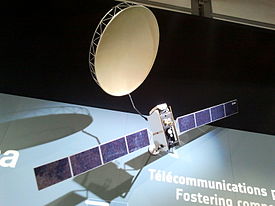Alphasat I-XL
| Alphasat I-XL | |
|---|---|
 Scale model, exhibited at the Paris Air Show . |
|
| Start date | July 25, 2013, 19:41 UTC |
| Launcher | Ariane 5 ECA V-214 |
| Launch site | CSG , ELA-3 |
| Takeoff mass | 6649 kg |
| Empty mass | approx. 3500 kg |
| Dimensions | 7.1 by 2.5 by 2.8 m |
| Span in orbit | 40 m |
| Manufacturer | Thales Alenia Space , Astrium |
| Satellite bus | Alphabus |
| operator | Inmarsat |
| Playback information | |
| Transponder | L-band with 12 m antenna |
| Others | |
| Electrical power | 12 kW |
| position | |
| First position | 25 ° East |
| drive | 400 N apogee motor , 10 N steering thrusters Pivoting PPS 1350 ion thrusters |
| List of geostationary satellites | |
Alphasat I-XL is the former name of a communications satellite that was built on behalf of Inmarsat and ESA by a European consortium of companies led by Thales Alenia Space (abbreviated to TAS) and Astrium . It should enter service at the orbital position 25 ° East over the equator.
payload
Alphasat I-XL should be used for Inmarsat cellular communication in the L-band , etc. a. with cell phones. He also carries an expandable antenna with a diameter of 11 meters. However, before it could be aligned with the earth, it was planned that the satellite would change its alignment in geostationary orbit by 90 ° compared to normal alignment.
Alphasat I-XL also has four ESA experiments on board:
- A unidirectional laser communications terminal ( Advanced Laser Communications Terminal ) that can receive data over 45,000 km at 1.8 Gbit / s and forward up to 600 Mbit / s to the ground via Ka-band . Connections are possible between the geostationary Alphasat I-XL and a satellite (e.g. Sentinel-1 A / B and Sentinel-2 A / B) in a low-earth orbit or an optical ground station. The terminal was developed by the German company Tesat-Spacecom , while the associated optics for the laser beam come from Switzerland; the terminal served primarily as a demonstrator for EDRS-A ;
- Tests of data transmission in Q / V band 38 - 48 GHz with spot beams to southern Italy IT1 (Tito), northern Italy IT2 (Spino) and Graz EU1 (Austria). The transponder was built by manufacturers from Italy. The three beams can be switched between the following 4 operating modes:
- IT1- IT2
- IT1- EU1
- IT1 loop and IT2 loop
- IT1 loop and EU1 loop
- a new type of star sensor from Germany, which is more accurate than previous models and has lower energy consumption;
- an experiment from a German-Portuguese collaboration to examine the effect of cosmic rays on electronic components made of gallium nitride instead of silicon.
Alphabus
The satellite is based on the alphabus , which was developed under the leadership of Astrium and TAS on behalf of ESA. As the first type of this series, the Alphasat I-XL should not yet exhaust the possibilities of the Alphabus. It was planned that it only consumed 12 kW of electricity and had a takeoff weight of around 6.6 t. The empty weight was given as 3.5 t and the span of the solar cell wings as 40 m.
Flight history
Alphasat I-XL was launched on July 25, 2013 with an Ariane 5 ECA and placed on a geostationary transfer orbit. On August 6, 2013, Alphasat reached its provisional position on the GEO orbit after the deployment of the antennas was successful. By November 2013, all of Alphasat's experimental payloads were activated.
The expected service life is 15 years
literature
- Andreas Mauroschat et al .: HITCHING A RIDE TO ORBIT, The 'hosted payloads' concept . ESA Bulletin 148 November 2011, ISSN 0376-4265 , p. 32 (English, esa.int [accessed on 23 August 2017]).
Individual evidence
- ↑ a b Press material on Ariane flight VA214 (PDFm English), Arianespace, accessed on July 26, 2013.
- ↑ Roland Rischer: The seventieth start of an Ariane 5 was successful . In Raumfahrer.net, July 25, 2013, accessed July 27, 2013
- ↑ a b Thomas Weyrauch: Construction of Alphasat I-XL is progressing , in Raumfahrer.net, date: February 21, 2010, accessed: July 27, 2013
- ↑ a b c Factsheet Alphasat. (PDF with 40 kB) ESA, June 10, 2011, archived from the original on August 4, 2012 ; accessed on November 5, 2012 .
- ↑ New technological territory with Alphasat. ESA, June 21, 2012, accessed November 5, 2012 .
- ^ B. Schlepp, R. Kahle, J. Saleppico, S. Kuhlmann, U. Sterr: Paper ISSFD "Laser Communication with Alphasat". (PDF) Retrieved September 16, 2019 (English).
- ↑ Alphasat Overview , ESA, accessed July 25, 2013
- ↑ Alphasat reaches temporary geostationary orbit. Inmarsat, August 6, 2013, accessed on August 22, 2017 .
- ↑ Laser beam from Alphasat satellite reaches intended target . ESA, November 13, 2013, accessed November 15, 2013.
- ↑ Press material on Ariane flight VA214 (PDF, English), page 21, Arianespace, accessed on January 13, 2020.
